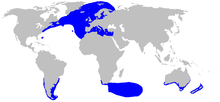Porbeagle
| Porbeagle | ||||||||||||
|---|---|---|---|---|---|---|---|---|---|---|---|---|

Porbeagle shark ( Lamna nasus ) |
||||||||||||
| Systematics | ||||||||||||
|
||||||||||||
| Scientific name | ||||||||||||
| Lamna nasus | ||||||||||||
| ( Bonnaterre , 1788) |
The porbeagle shark ( Lamna nasus ) is a species of the mackerel shark family .
Appearance
The porbeagle is up to three meters tall. Its appearance is strongly reminiscent of the great white shark . Its spindle-shaped body has a conical snout. The presumed maximum age is 30 years.
Distribution area
The main distribution areas of the porbeagle are the waters of the North Atlantic . It is very widespread in the North Sea . Herring sharks sometimes find their way into the western Baltic Sea via the Kattegat and Skagerrak . You can also find it in the Mediterranean. Herring sharks are native to the southern hemisphere around South Australia, off Chile and in regions of the sub-Antarctic.
Way of life
Schooling fish and smaller whales are its main source of food. But also smaller shark species have already been discovered in gastric analyzes. He's also prone to cannibalism .
The porbeagle is viviparous. A female gives birth to an average of one to five young, which are usually 75 centimeters tall.
Humans and porbeagle sharks
Some attacks on humans are known in Europe. The shark may view swimmers in coastal waters as prey. On the other hand, the porbeagle serves as food fish for humans .
Due to severe overfishing in the early 1970s, stocks in the North Atlantic plummeted. Only in 2001 was there a noticeable stabilization of the population here. Overall, the stock is on the decline. According to the IUCN , the porbeagle is classified as endangered (“vulnerable”) (in the north-east Atlantic and the Mediterranean area: “critically endangered” and in the north-west Atlantic: “critically endangered”). A listing in Appendix 2 of the CITES list was applied for in 2007, but was rejected. In 2007 and 2008, the IUCN announced that the porbeagle shark would retain its vulnerable status on the basis of an investigation by the IUCN SSC Shark Specialist Group (SSG) into pelagic shark and ray species.
In March 2013, at the CITES Species Conservation Conference in Bangkok , it was decided to regulate the trading of porbeagles. The regulation came into force on September 14, 2014.
supporting documents
- ↑ spiegel.de: More sharks in the Baltic Sea than previously known , May 15, 2008
- ↑ Lamna nasus in the endangered Red List species the IUCN 2008 Posted by: J. Stevens u. a .. Retrieved January 2, 2009.
- ↑ More oceanic sharks added to the IUCN Red List (PDF; 13 kB) Press release from February 2, 2007.
- ↑ You can swim but you can't hide - more oceanic sharks on the IUCN Red List press release of the IUCN of May 22, 2008
- ↑ Cites resolution: Endangered shark and manta ray species should be protected Spiegel Online from March 11, 2013
- ↑ Species protection: These sharks must now be better protected by humans. The time of September 12, 2014
literature
- Leonard Compagno , Marc Dando, Sarah Fowler: Sharks of the World. Princeton Field Guides, Princeton University Press , Princeton and Oxford 2005; P. 184. ISBN 978-0-691-12072-0 .
- Alessandro de Maddalena, Harald Bänsch: Sharks in the Mediterranean, Franckh-Kosmos Verlags-GmbH, Stuttgart 2005; Pages 152-155. ISBN 3-440-10458-3 .
Web links
- Porbeagle on Fishbase.org (English)
- Porbeagle in the hai.ch database
- Brenda Roman: Porbeagle. Florida Museum of Natural History. Accessed October 15, 2008
